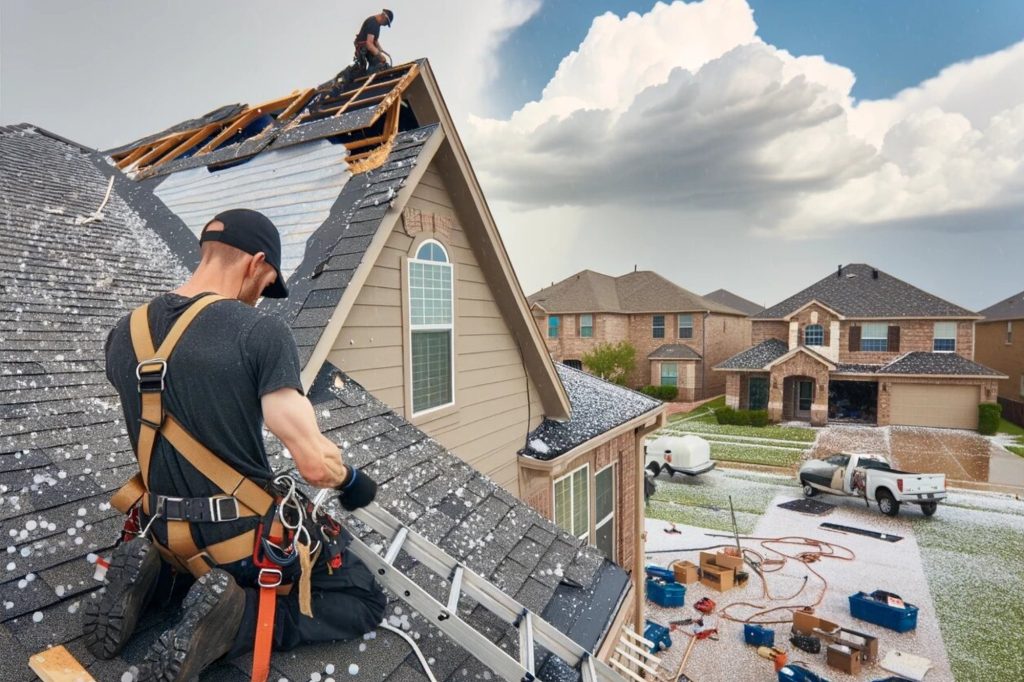Signs of Roof Hail Damage in Columbia MD
Roof damage is a common issue for homeowners, especially in areas prone to severe weather. In Columbia, MD, the unpredictable weather can cause significant damage to your roof. Understanding the types of damage and how to identify them can save you from costly repairs.
The Impact of Hail Damage on Your Roof
Hail damage is one of the most severe types of storm damage. Hailstones can range from tiny pebbles to golf-ball-sized chunks of ice, and when they hit your roof, they can cause serious damage. This type of damage not only affects the appearance of your roof but can also compromise its structural integrity.
Identifying Hail Damage vs. Other Storm Damage
Hail damage can be distinguished from other types of storm damage by looking for specific signs. Knowing these differences can help you address the right issues when inspecting your roof:
- Hail Damage:
- Dents and Dings:
- Hailstones often leave noticeable dents and dings on shingles and metal roofing.
- These indentations are usually round and can vary in size depending on the hailstone.
- Bruising:
- Bruising occurs when the impact from hailstones creates soft spots on the shingles.
- You can feel these bruises by running your hand over the shingles and feeling for areas that give slightly.
- Granule Loss:
- Hail impacts can knock off the granules that cover asphalt shingles.
- Check your gutters and downspouts for an accumulation of these granules.
- Cracks and Splits:
- Severe hailstorms can cause shingles to crack or split.
- Look for visible cracks in the shingles, which can lead to leaks and further damage.
- Dents and Dings:
- Wind Damage:
- Lifted or Missing Shingles:
- High winds can lift shingles, breaking the adhesive seal, and may even rip shingles off the roof entirely.
- Look for uneven or missing shingles after a windstorm.
- Curling Shingles:
- Wind can cause the edges of shingles to curl or peel back.
- This curling compromises the protective layer of your roof and can lead to water infiltration.
- Debris Impact:
- Wind can blow debris onto your roof, causing punctures or damage.
- Check for branches, leaves, and other debris that may have struck the roof.
- Loose or Damaged Flashing:
- Flashing around chimneys, vents, and other roof penetrations can be loosened or damaged by strong winds.
- Inspect these areas closely for signs of lifting or displacement.
- Lifted or Missing Shingles:
By understanding these signs, you can better identify the type of damage your roof has sustained and take the appropriate action. Whether it’s hail damage or wind damage, contacting a professional roofing contractor like Columbia Roofing ensures that your roof is inspected, assessed, and repaired correctly.
Common Signs of Roof Hail Damage
Dents and Dings in Shingles
Hailstones can leave noticeable dents and dings on your shingles. These indentations are usually random and can vary in size depending on the hailstone’s size.
Bruising on Shingles
Bruising is another common sign of hail damage. Run your hand over your shingles; if you feel soft spots or areas that give slightly, these could be bruises caused by hail impact.
Granule Loss on Shingles
Check your gutters and downspouts for an accumulation of granules. Hail impacts can knock these protective granules off your shingles, reducing their effectiveness.
Cracks and Splits in Shingles
Severe hailstorms can cause shingles to crack or split. Inspect your roof closely for any visible cracks, as these can lead to leaks and further damage.
Examining Specific Roof Areas for Hail Damage
When inspecting for hail damage, focus on specific areas that are more vulnerable, such as roof vents, skylights, gutters, downspouts, flashing, and chimneys. These areas often show signs of impact more clearly than the flat sections of your roof.
The Role of Roofing Material in Hail Damage
Different roofing materials respond differently to hail. Asphalt shingles might show dents and granule loss, while metal roofing might have visible dents. Tile roofs can crack under the impact of hailstones. Understanding how your specific roofing material responds to hail can help you better assess damage.
Short-Term Effects of Hail Damage on Your Roof
In the short term, hail damage can lead to leaks and water damage inside your home. This can result in stains on your ceilings and walls, and potentially lead to mold growth if not addressed promptly.
Long-Term Consequences of Ignoring Hail Damage
Ignoring hail damage can lead to severe long-term consequences. Over time, the damage can worsen, leading to significant structural issues, higher repair costs, and even the need for a full roof replacement. Additionally, persistent leaks can damage the interior of your home, including insulation, electrical systems, and more.
Steps to Take After Suspecting Hail Damage
If you suspect hail damage, the first step is to conduct a visual inspection. Look for the common signs mentioned above. Next, contact a professional roofing contractor, like Columbia Roofing, for a thorough assessment. Document the damage with photos and notes to assist with any insurance claims.
The Importance of Timely Roof Restoration
Timely roof restoration is crucial to prevent further damage. Addressing hail damage quickly can help maintain the integrity of your roof, protect your home from water damage, and extend the life of your roofing system.
Roof Replacement vs. Roof Restoration: Making the Right Choice
Deciding between roof replacement and restoration depends on the extent of the damage. Minor damage might only require restoration, which is less costly and faster. However, extensive damage might necessitate a full roof replacement to ensure your home’s safety and structural integrity.
Working with Roofing Contractors for Hail Damage Repair
Choosing the right roofing contractor is essential for quality repair work. Columbia Roofing offers expert roofing services in Columbia, MD. Our local contractors specialize in roof restoration and replacement, ensuring your home is well-protected. We pride ourselves on superior customer service and strive to earn your referrals.
Preventative Measures to Protect Your Roof from Future Hail Damage
Preventative measures can help minimize future hail damage and extend the lifespan of your roof. Here are some effective steps to consider:
- Install Impact-Resistant Shingles:
- Enhanced Durability:
- Impact-resistant shingles are designed to withstand hail and other severe weather conditions.
- These shingles are made from stronger materials, reducing the risk of dents and cracks.
- Better Protection:
- They provide better protection against both hail damage and high winds.
- Look for shingles rated Class 4 by the Underwriters Laboratories (UL), which indicates the highest level of impact resistance.
- Enhanced Durability:
- Regular Roof Maintenance:
- Routine Inspections:
- Schedule regular roof inspections to identify and address minor issues before they become major problems.
- Inspect your roof at least twice a year and after significant storms.
- Cleaning Debris:
- Keep your roof free from debris such as leaves, branches, and dirt, which can trap moisture and cause damage.
- Clean gutters and downspouts regularly to ensure proper drainage.
- Repair Minor Damage:
- Promptly repair any minor damage, such as loose or missing shingles, to prevent further deterioration.
- Routine Inspections:
- Apply Protective Coatings and Sealants:
- Additional Layer of Protection:
- Apply protective roof coatings to add an extra layer of defense against hail and UV damage.
- These coatings can also help reduce energy costs by reflecting sunlight.
- Sealants:
- Use high-quality sealants around roof penetrations, such as chimneys, vents, and skylights, to prevent water infiltration.
- Ensure that the sealants remain in good condition and reapply as necessary.
- Additional Layer of Protection:
- Trim Overhanging Branches:
- Reduce Impact Risk:
- Trim tree branches that hang over your roof to minimize the risk of branches breaking off during a storm and causing damage.
- Keep trees well-maintained to prevent limbs from falling on your roof during high winds or hailstorms.
- Reduce Impact Risk:
- Install Roof Guards and Screens:
- Gutter Protection:
- Install gutter guards to prevent leaves and debris from clogging your gutters, ensuring proper water drainage.
- Use screens to protect roof vents and skylights from hail impact.
- Gutter Protection:
- Strengthen Roof Structures:
- Reinforce Roof Decking:
- Strengthen the roof decking by using thicker or more resilient materials.
- Ensure that the roof decking is securely fastened to the frame of the house.
- Upgrade Underlayment:
- Use high-quality underlayment that offers additional protection against water and ice.
- Reinforce Roof Decking:
- Consider Roof Replacement with Modern Materials:
- Modern Roofing Solutions:
- If your roof is old or extensively damaged, consider replacing it with modern, durable materials that offer better protection against hail.
- Materials like metal roofing and advanced composite shingles can provide superior durability and longevity.
- Modern Roofing Solutions:
By implementing these preventative measures, you can significantly reduce the risk of hail damage to your roof. Investing in impact-resistant materials, maintaining your roof regularly, and applying protective coatings are all effective ways to protect your home from future hailstorms. Columbia Roofing offers comprehensive roofing services to help you safeguard your roof and maintain its integrity for years to come.
Trusted Roof Contractor Columbia Roofing
Hail damage can significantly impact your roof and home, but understanding the signs of hail damage in Columbia MD, and taking prompt action can mitigate these effects. If you suspect hail damage, don’t hesitate to contact Columbia Roofing for professional assessment and repair. Protect your home with timely roof restoration and preventative measures to ensure long-term safety and comfort.
Roof Hail Damage FAQs
How can I tell if my roof has hail damage?
Look for signs like dents, dings, bruises, granule loss, and cracks in your shingles. Also, check specific areas like roof vents, skylights, and gutters for impact marks.
What should I do if I suspect hail damage on my roof?
Conduct a visual inspection and document the damage with photos. Then, contact a professional roofing contractor like Columbia Roofing for a thorough assessment and repair.
How does hail damage differ from other storm damage?
Hail damage typically leaves dents, bruises, and granule loss on shingles, while wind damage might rip off shingles or cause them to lift. Knowing these differences helps in accurate damage assessment.
What are the long-term consequences of ignoring hail damage on my roof?
Ignoring hail damage can lead to severe structural issues, higher repair costs, persistent leaks, mold growth, and the potential need for a full roof replacement.
How do different roofing materials respond to hail damage?
Asphalt shingles may show dents and granule loss, metal roofing might have visible dents, and tile roofs can crack. Understanding your roofing material helps in assessing and addressing damage effectively.
Why is timely roof restoration important after hail damage?
Timely roof restoration prevents further damage, maintains the roof’s integrity, protects your home from water damage, and extends the roofing system’s lifespan. Contact Columbia Roofing for prompt and professional repair services.






